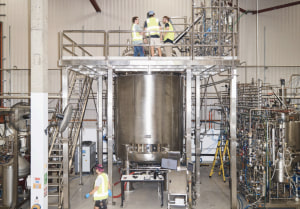Australia’s consumption of fibre packaging lifted above 1.7 million tonnes in 2020-21, to a new record that hovers tantalisingly close to 1.8 million tonnes. Tim Woods, MD of Industry Edge, writes for PKN.
Demand for locally produced or converted corrugated boxes, folding cartons, bags, sacks, pouches and other fibre-packaging was very strong over 2020-21 and was again supplemented by a fast-growing import supply of fully converted packaging products.
As sustainability concerns continued to mount about the materials used in packaging, the growth in consumption of fibre-packaging was significant over the last five years.
In the year of the pandemic however, radical supply chain adjustments impacted everything, including packaging. More than ever, the advantages of fibre packaging (and for many activities, its existing dominance), appeared to be accentuated.
As a result, full year data shows fibre-packaging consumption grew for every main application and product type, including for related products like plasterboard liner. The latter’s demand was driven upwards by housing-related fiscal stimulus.
The continued market dominance of the not-so-humble corrugated box is etched into the Australian economy for decades to come, of course. Evidence of that includes that despite solid growth in some other grades, corrugated boxes accounted for 80 per cent of the total fibre packaging market in 2020-21.
Australia’s fibre products are delivered largely from locally manufactured paper and board. The import proportion is around 20 per cent in total, but for the core volume – corrugated boxes – the proportion of imports is a far smaller nine per cent.
This last year’s experience has been supported by consistent trends that constitute a suite of powerful drivers towards the use of fibre packaging. These are drivers of the future, as much as they are relics of the most utterly strange year in collective memory.
PLASTIC REPLACEMENT DRIVES GROWTH
Driven increasingly by brand owners, but ultimately by consumers, single-use plastics are under pressure, even where they are manufactured from recycled materials. As our global partner, Fisher International points out:
“As many governments respond by implementing new taxes and bans on plastic, brand owners are substituting renewable materials for many types of plastic packaging.”
The trend is driving fibre-based packaging companies and researchers to develop 100 per cent fibre bottles, fibre-based meat trays and similar food contact products. Research is even underway to remove plastics from existing laminated food contact packaging, from products as diverse as contact barrier films to the polyethylene used on most liquid packaging boards
This approach is driving demand for fibre-based packaging and the pace of growth is also increasing.
E-COMMERCE FAVOURS FIBRE
The pandemic hastened the trend towards e-commerce and home delivery and away from physical retail. That rapid evolution has altered packaging flows, with many more packaging items being delivered to households than was previously the case.
Initially, the supply chain was ill-equipped for the rapid and overnight expansion of this development. It had the volume of packaging required in hand for the most part, but not always of the sizes suitable for smaller volume deliveries to households.
That has quickly changed.
From corrugated boxes that are available in smaller sizes, through ever-smaller cartons and especially into fibre-based pouches, envelopes, parcels and sleeves – some also padded using shredded fibre – the supply-chain evolution has been rapid and is continuing.
Consumption of the latter products, the imported fibre-based pouches, parcels or sleeves, more than doubled at the onset of the pandemic. Demand remained at record highs long after most other packaging materials returned to relatively normal consumption patterns in early 2021. Year-ended June, their consumption was up an eye watering 73 per cent, feeding into almost 13 per cent growth in total imported finished fibre-packaging demand over the year.
Among the other specific grades of fibre-based packaging to experience growth in the pandemic, the other stand-out is retail sized paper bags. Demand lifted 27 per cent year-on-year, as every home delivery rider can attest.
These products supported the swing to household deliveries, but at the same time, that has meant a larger proportion of fibre packaging is now finding its way into the kerbside recycling bin than ever before.
RECYCLED FIBRE USE GROWS
IndustryEdge’s preliminary estimates indicate Australia’s use of recovered fibre lifted over the year-ended June 2021, rising around 2.2 per cent to almost 1.9 million tonnes – the highest level in at least a decade.
We calculate that over the year, around 75 per cent – something more than 1.3 million tonnes – of the fibre-packaging made locally and used in Australia was manufactured from recovered paper.

Our analysis of the trade data shows that Australia also exported 0.4 million tonnes of paper and board made from recovered paper.
In addition to the local use of recovered paper, the global paper industry purchased 1.0 million tonnes of Australia’s recovered paper over the year.
FIBRE’S TIME IS NOW
There is no doubt fibre packaging is on the right side of history.
Made from a renewable, biologically derived resource, already recycled at far higher proportions than all other packaging materials, manufactured with less embodied energy, there is growing recognition of the advantages of fibre packaging from a sustainability perspective.
Reflected in brand owner decisions and observed in supply chains, all the way through to the kerbside recycling system, fibre-based packaging is growing its contribution, even as it grows its market share.
WHAT’S NEXT FOR FIBRE PACKAGING?
Demand for fibre resources has never been more concentrated globally, including for packaging. Fibre availability has, at the same time, never been more constrained.
The decades-long emphasis on recovery and recycling of fibre means that in most countries – not all – the easy recovery gains have been taken up. Recovering additional fibre is more challenging. And more expensive.
Developments in fibre-based packaging are taking these factors into account, ensuring optimal use of available resources, and making recovery and recycling easier.
Market growth will see an emphasis on resource efficiency continue. However, new capacity cannot be too far distant. The questions of when, who, where and how much (volume and cost) might not be resolved, but they cannot be many years off.
Over coming years, the market expects to see more single material laminates and inserts, at the same time as there is continued growth in recycled and recyclable pouches, sleeves and other sustainable home delivery options.
Lightweighting of corrugated boxes and some cartons continues, to maximise resource use, and as the Tokyo Olympics and Paralympics have demonstrated, the power of corrugation is extending the use of fibre to furniture and other items.
These are the trends that will shape the future of fibre packaging.
Tim Woods is MD of Australia’s leading fibre packaging market analysis and consulting firm IndustryEdge, which provides subscription data, market intelligence and related business and consulting services. Find out more at industryedge.com.au
This article has been published in the September-October print issue of PKN Packaging News, on page 12-13.






